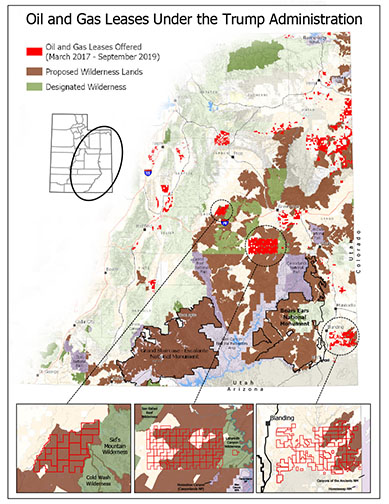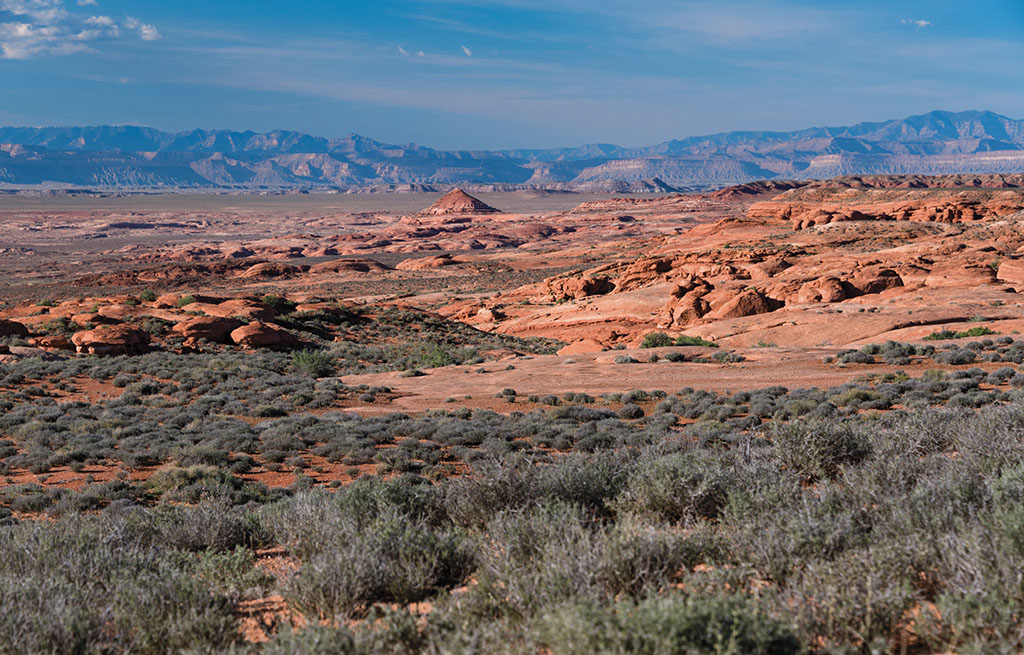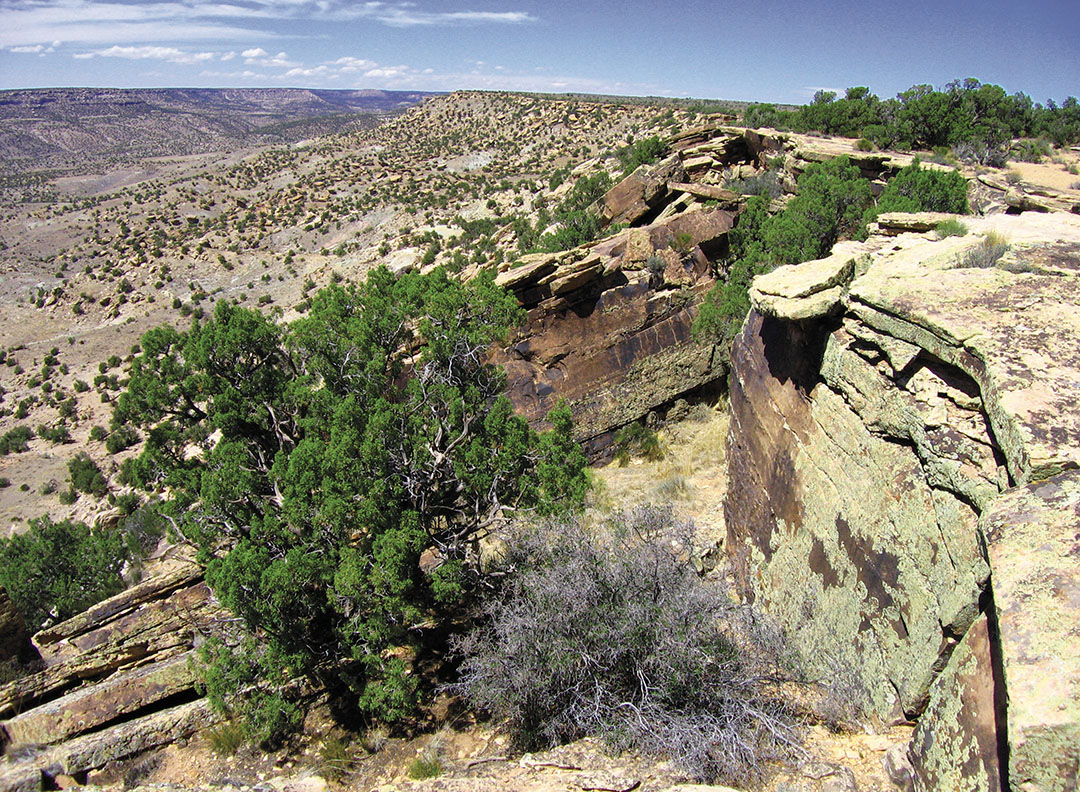BREAKING NEWS: Trump Administration’s “Lease First, Think Later” Mentality Backfires on the BLM
As this newsletter was going to press, we learned that the Bureau of Land Management (BLM) has admitted that its rushed “lease first, think later” approach to oil and gas leasing violated the law. The BLM informed SUWA that the agency will reconsider opening up over 200,000 acres in the San Rafael Desert and northern Dirty Devil region for oil and gas development. This decision follows on the heels of another one in which the BLM pulled back a separate decision to offer leases on the doorstep of Bears Ears National Monument and Canyonlands National Park. Because all of the BLM’s leasing decisions in Utah over the past two years suffer from the same legal flaws, we expect that the agency will be forced to pull back hundreds of thousands of acres of oil and gas leases across Utah that were issued since the Trump administration came to power, and which SUWA has challenged.
Thanks to your support, the uninformed rush for “energy dominance” has come back to haunt the BLM. It may help to keep this good news in mind as you read the story that follows.
Cliché or no, there truly are people who know the price of everything and the value of nothing. Tragically, they now run our country.
The Trump administration took office in January 2017 and quickly declared that the nation’s goal was no longer merely “energy independence” but rather “energy dominance.” Since then there has been a more-than-sevenfold increase in the amount of land managed by the Bureau of Land Management (BLM) in Utah offered for oil and gas leasing and development. The torrent of new leasing has opened some of America’s wildest lands to development, including tracts near Bears Ears National Monument, in the San Rafael Swell, and in the Uinta Basin’s Book Cliffs region.
The BLM is doing its zealous best to remove every obstacle that might slow the Trump plan, showing more enthusiasm for plunder than it ever has for balance, much less for protection. The obvious first step is to slam the door on public participation; that agency has taken that step. Next is to scuttle rules that require the BLM to conduct meaningful environmental reviews; the agency has done that too. The public’s response is justifiable outrage, widespread protests, and litigation. The agency is auctioning off our public lands heritage for unbridled energy development and auctioning it off for a pittance. The greed-driven development that Trump promised the industry will destroy some of our last wild places, harm wildlife, and exacerbate the climate crisis.
But there is a faint light at the end of this dark tunnel. Predictably, Trump’s BLM rushed forward to open up as much public land for development as possible. But its slapdash haste produced several serious mistakes. Those mistakes have paved the way for a deluge of successful litigation challenging all aspects of the agency’s implementation of the energy dominance agenda.
Look Before You Lease: How the Process is Meant to Work
It is important to understand at the outset that the BLM has no legal obligation to offer any tract of public land for oil and gas leasing and development regardless of whether that land is identified as available for leasing under the relevant BLM land management plan. If the BLM receives an industry “expression of interest” to lease a particular tract of land, it first confirms whether the land is available for leasing. It is then supposed to consider whether the lease should be offered at an upcoming sale and, if so, under what terms and conditions. If offered, the lease can be sold competitively for as little as $2 per acre—even less, $1.50 an acre, if the lease is sold noncompetitively. A lease is issued for a ten-year period but can be—and too often is—extended by the BLM for years or decades beyond its primary term.
Energy leases open the door to development. Once a lease is issued, the BLM does not have the legal authority to outright prohibit surface-disturbing activities associated with its development. In other words, by issuing a lease the BLM commits itself to oil and gas development even if it later determines that development will exacerbate climate change or cause irreparable harm to resource values such as wilderness characteristics or wildlife. This fact makes it critical that the agency consider its lease offerings carefully and take public input seriously and to do so first.

Making the Same Mistake Twice: Energy Dominance Part II
The Trump administration, despite all its internal chaos, late-night Twitter rants, and incoherent messaging, has clung tenaciously to at least one promise: undo every policy, regulation and goal of Barack Obama’s administration regardless of effectiveness or need. Nowhere is this more evident than with the BLM’s massive push over the past two years to sacrifice public lands for energy development.
If the BLM’s expansive sell-off of public lands for energy development seems vaguely familiar, it is because we have seen this loathsome movie before. Throughout the early 2000s, the Bush administration aggressively moved to prioritize leasing and development as the most important use of public lands. This “lease everything, lease everywhere” approach to development resulted in several high-profile SUWA lawsuits and highly publicized federal court rulings overturning the agency’s leasing decisions.
Thankfully, in 2010, the Interior Department recognized that the BLM’s leasing program was broken and took several steps to better balance energy development with environmental protections. Under President Obama, the agency first established a comprehensive lease parcel vetting process to determine which public lands should be offered for development at a particular lease sale. This structured approach to leasing allowed the BLM sufficient time to consider nominated lease parcels, to determine which parcels should be offered and which not, to prepare comprehensive environmental reviews, and to consider public input.
The BLM then established the “master leasing plan” (MLP) process. These plans encouraged the agency to do exactly what it should have been doing all along: think first, lease later. Specifically, the process was an opportunity for the agency, as it put it, to “analyze in greater detail the impacts of leasing and development in areas where there are likely resource conflicts” and to provide “a road map to guide the orderly development of oil and gas resources, while also protecting other important resources.” The Utah BLM’s Moab Master Leasing Plan is an example of this good idea at work. That plan, finalized in 2016, offered the prospect of long-term protections for hundreds of thousands of acres of public lands near Canyonlands and Arches national parks, including the wilderness-caliber lands of Porcupine Rim, Fisher Towers, Six-Shooter Peaks, and Goldbar Canyon.
A Temporary Reprieve
Notably, the BLM acknowledged that MLPs were “required” for more than 3 million acres throughout eastern and southern Utah, including lands near Bears Ears National Monument and in the San Rafael Desert and Book Cliffs regions. The agency said plans would be required before new leases were offered for development to allow the agency time to analyze potential impacts on climate, wilderness characteristics, and wildlife. In the short term, this protected millions of acres of public lands in Utah.
Unfortunately, those leasing reforms were short-lived. In March 2017, Trump issued an executive order requiring all federal administrative agencies, including the BLM, to “review all existing . . . orders, guidance documents, policies, and any other similar agency actions . . . that potentially burden the development or use of domestically produced energy resources, with particular attention to oil [and] natural gas.”
Soon thereafter, then-Interior-Secretary Ryan Zinke directed the BLM to “identify additional steps to enhance exploration and development of Federal onshore oil and gas resources.” His order further required the agency to “identify any provisions in [its] existing policy and guidance documents that would impede BLM’s plans to carry out quarterly oil and gas lease sales or its efforts to enhance exploration and development of Federal onshore oil and gas resources.”
Without analysis or public review the agency quietly abandoned its earlier leasing reforms and fell into lockstep with the Trump administration’s energy dominance lunacy. The agency hatched a plan of attack for leasing that eerily resembles its broken leasing program from the early 2000s. Among other things, this new framework (1) eliminated MLPs, (2) eliminated or significantly restricted opportunities for public involvement in leasing decisions, and (3) encouraged the BLM to rely on existing environmental analyses (rather than preparing new site-specific analyses) in order to “streamline” energy leasing and development.
The Utah BLM has embraced Trump’s energy dominance agenda by removing every obstacle to selling off as much federal public land as possible, as quickly as possible, and with as little analysis or public involvement as possible.

What This All Means for Utah’s Wild Places
With the recently announced September 2019 proposed lease offerings added to the mix, over the past two years the BLM’s Utah offices have offered a staggering 644 leases, covering 904,463 acres of public lands, for energy development. In the crosshairs of development are:
• Public lands on the doorsteps of Bears Ears, Canyons of the Ancients, and Hovenweep national monuments in southeastern Utah. These lands contain a remarkably high density of irreplaceable cultural and archaeological sites. The Advisory Council on Historic Preservation has termed those sites “world-class resources.” They include highly sensitive pre-Columbian settlements, rock art panels, kivas, and other remains. The National Trust for Historic Preservation recently included the area on its list of “America’s 11 Most Endangered Historic Places for 2019,” citing the BLM’s “dramatically escalated leasing activity” as the primary threat.
• The San Rafael Desert—a rugged expanse between Goblin Valley State Park and the San Rafael Reef on the west and Canyonlands National Park and the Dirty Devil on the east. Among its many unique values, this area is home to an astonishingly diverse array of native and endemic bees.
• The Molen Reef region of the San Rafael Swell—another area of impressive cultural and archaeological diversity and density. Molen Reef is home to hundreds of significant documented cultural sites, including Ferron Box, Funk’s Cave, Clyde’s Cavern, and Horn Silver Gulch.

Straining Common Sense: The Courts Confront Trump’s Oil and Gas Fantasies
Thankfully, the Trump administration’s energy dominance agenda has suffered several significant legal setbacks. In September 2018, a federal judge in the district of Idaho held that the BLM’s elimination of public participation from its leasing decisions violated federal laws. The judge noted that it “strain[ed] common sense” to see how the BLM’s elimination of public participation met the applicable legal standard, which required such participation “to the fullest extent possible.” This court decision will have sweeping ramifications. In Utah, for example, over the past two years the agency has taken similar steps to eliminate public participation. All the resulting leasing decisions almost certainly violated the law and are thus susceptible to legal attack.
There was another decision with national implications in March 2019. A federal judge in Washington, DC held that the BLM had failed to properly analyze the impacts of its oil and gas leasing program on greenhouse gas emissions and climate change. This landmark decision requires the BLM—for the first time—to provide a detailed accounting of these impacts in each leasing decision. This ruling spells trouble for all the Utah BLM’s leasing decisions over the past two years: the agency made the same unlawful mistake in each. SUWA has already filed the first of several court challenges to start to overturn all these decisions.
SUWA has been engaged in every leasing and development decision affecting wilderness-caliber lands in Utah. We recently filed a lawsuit challenging the BLM’s March 2018 and December 2018 leasing decisions for public lands near Bears Ears and Hovenweep national monuments. Other lawsuits are in the works. And we have successfully challenged several drilling projects that would have impacted public lands proposed for wilderness designation.
Where does all this leave us? Despite the reckless rush to lease everything in sight, not a single oil and gas well has been drilled on lands proposed for wilderness in America’s Red Rock Wilderness Act since the Trump administration took office. Nevertheless, we expect the BLM to aggressively push Trump’s megalomaniacal energy dominance agenda over the next eighteen months. SUWA is ready for the challenge. The lease first, think later mentality will surely backfire; most stupid ideas do.
—Landon Newell
(From Redrock Wilderness newsletter, summer 2019 issue)

